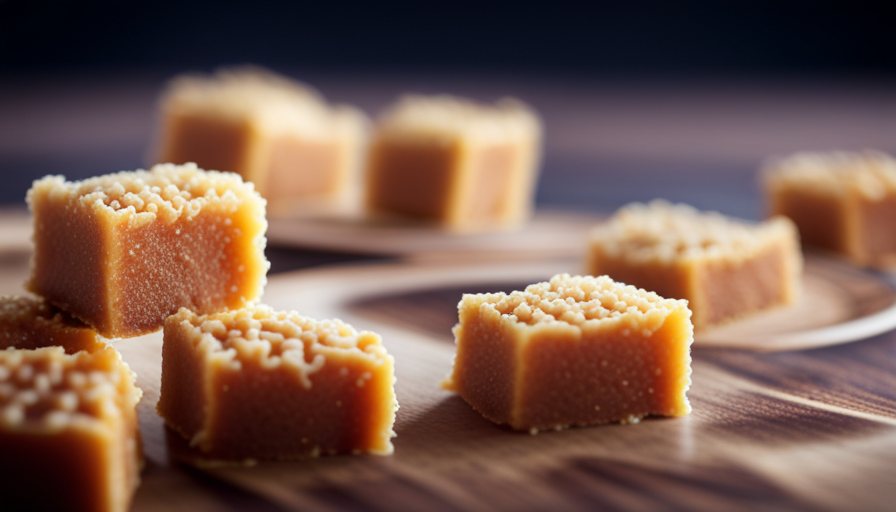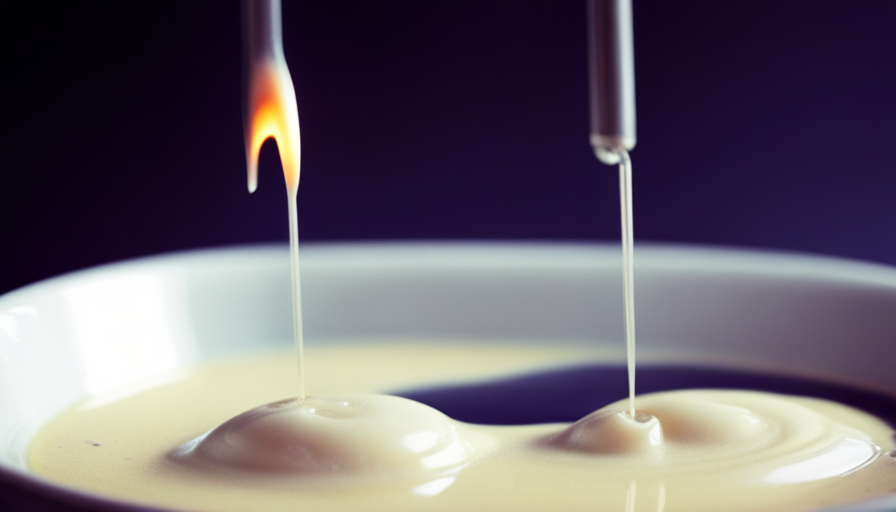After savoring your beloved candle to the very end, you may be faced with the task of properly disposing of it. Don’t worry, I’m here to guide you through the process.
In this article, I’ll guide you through the process of safely and responsibly disposing of a candle.
Let’s start with a real-life example to illustrate the importance of proper candle disposal. Sarah, a candle enthusiast, recently had a mishap when she poured hot wax down her kitchen sink. The result? A clogged drain and an expensive plumbing bill. Sarah quickly realized that she should have known better and sought out the proper way to dispose of her candles.
In this article, I’ll show you step-by-step how to dispose of a candle without any negative consequences. From extinguishing the candle safely to recycling the container, we’ll cover it all.
So, let’s get started and ensure that your candle-burning experience ends on a high note, with no mess or damage left behind.
Key Takeaways
- Properly disposing of candle wax is important for reducing waste and minimizing environmental impact.
- Recycling centers often accept wax made from natural materials like soy or beeswax.
- Composting wax can provide nutrient-rich soil for plants and reduce the need for chemical fertilizers.
- DIY projects using leftover wax can transform it into unique creations using decorative candle molds.
Extinguish the Candle Safely
To extinguish the candle safely, simply pinch the wick gently between your fingertips and watch as the glowing flame fades away, leaving behind a trail of delicate smoke. This method ensures that the flame is completely extinguished without causing any damage or spreading any sparks. It’s important to use safe methods when dealing with fire to prevent accidents and maintain a secure environment.
When pinching the wick, make sure to do it gently to avoid any hot wax splattering. This technique not only puts out the flame effectively but also minimizes the risk of accidentally dropping the candle or causing a fire. By taking these precautions, you can ensure a safe and hazard-free environment.
Once the flame is extinguished, the next step is to allow the wax to harden. This is a crucial step as it prevents any spills or accidents while disposing of the candle. Allowing the wax to cool and solidify ensures that it can be easily handled without any mess or risk of burns.
Once the wax is hardened, you can then move on to the proper disposal methods.
Allow the Wax to Harden
Once the wax has hardened, you can easily remove it from the container with a few simple steps.
Did you know that approximately 1 billion pounds of wax are used to make candles each year in the United States alone? It’s quite astonishing!
Now, let’s talk about what you can do with that hardened wax. One option is to reuse it. You can melt down the wax and create new candles or even use it to make wax melts for your wax warmer.
To melt the wax, there are a few techniques you can try. One popular method is the double boiler method, where you place the wax in a heat-resistant container and then place that container in a pot of boiling water. Another option is to use a candle warmer, which gently heats the wax until it melts. These techniques ensure that the wax is melted safely and efficiently.
Now that you know how to reuse the wax, let’s move on to the next step and learn how to remove any remaining wax from the container.
Remove any Remaining Wax
First, gently scrape off any remaining wax from the container using a butter knife or a similar tool. Be careful not to scratch the container while doing so.
Once you have removed as much wax as possible, there are several ways you can reuse the candle or its remnants:
- Melt the leftover wax and pour it into a new container or mold to create a new candle.
- Use the wax to lubricate sticky drawers or squeaky hinges.
- Make fire starters by placing small pieces of wax in a cupcake liner with a wick.
- Create wax sachets by placing scented wax pieces in a fabric pouch and using them to freshen up drawers or closets.
- Mix the wax with other ingredients like essential oils or dried flowers to make homemade wax melts for a wax warmer.
By reusing the candle or its remnants, you can minimize waste and get more use out of your purchase.
Once you have removed the remaining wax, it’s time to move on to the next step: cleaning the candle holder.
Clean the Candle Holder
After you’ve successfully removed the remaining wax, it’s time to give the candle holder a sparkling makeover. Cleaning the candle holder is important not only for aesthetic reasons but also to ensure that it’s free from any residue that may affect future candles.
There are various cleaning techniques you can use, depending on the material of your candle holder.
For glass holders, a simple solution of warm water and dish soap works wonders. Gently scrub the inside and outside of the holder with a soft cloth or sponge to remove any stubborn stains or residue. Rinse it thoroughly with warm water and pat it dry with a clean towel. This will leave your glass holder looking as good as new.
If you have a metal candle holder, you can use a mixture of vinegar and baking soda to remove any tarnish or discoloration. Apply the mixture to the holder using a cloth or sponge, and scrub gently until the stains are gone. Rinse it off with warm water and dry it completely to prevent any rusting.
Once your candle holder is clean, you can also consider alternative uses for it. Glass holders can be repurposed as small vases for flowers or storage containers for small items. Metal holders can be used as plant pots or decorative objects. The possibilities are endless!
Now that your candle holder is clean and ready for a new purpose, let’s move on to the next step of recycling the glass or metal container.
Recycle the Glass or Metal Container
To give your candle holder a new lease on life, consider recycling the glass or metal container. Recycling is one of the best ways to dispose of a candle holder in an eco-friendly manner. Not only does it help reduce waste, but it also allows the materials to be reused, reducing the need for new resources.
Here are some recycling options and eco-friendly alternatives for your candle container:
-
Take it to a recycling center: Most glass and metal containers can be recycled at your local recycling center. Simply clean the container and drop it off. Recycling centers have specialized processes to break down and reuse these materials.
-
Repurpose it as a storage container: Clean the container thoroughly and use it to store small items like buttons, jewelry, or office supplies. This way, you can give it a second life while organizing your space.
-
Use it as a plant pot: Transform your candle container into a mini planter by adding soil and a small plant. It can make a charming addition to your home decor while being eco-friendly.
-
Donate it to a local crafter: Some crafters love using recycled materials in their projects. Consider donating your candle container to a local artist or craft store.
-
Upcycle it into a decorative item: Get creative and repurpose the container into a decorative object, such as a votive holder or a pen holder. Let your imagination run wild and give the container a new purpose.
By recycling the glass or metal container, you not only contribute to a more sustainable future but also open up possibilities for repurposing the container in creative ways.
In the next section, we’ll explore how to repurpose the container even further.
Repurpose the Container
Get ready to unlock the hidden potential of your glass or metal container by repurposing it into something unique and stylish. When it comes to repurposing candle containers, the possibilities are endless. Let me share some repurpose ideas that’ll inspire your creativity and help you give your container a new life.
One creative use for your candle container is to turn it into a mini succulent planter. Clean out the container thoroughly, add some small rocks for drainage, and fill it with soil. Plant your favorite succulent and watch it thrive in its new home. Not only will it add a touch of greenery to your space, but it’ll also serve as a conversation starter.
Another great idea is to transform your container into a stylish makeup brush holder. Clean out the container and fill it with small beads or decorative stones. This’ll help keep your brushes upright and organized, while also adding a chic touch to your vanity.
Before we move on to the next section on how to dispose of the wax properly, let’s explore more creative ways to repurpose your candle container.
Dispose of the Wax Properly
Once you’re done enjoying the beautiful glow of your candle, it’s important to handle the leftover wax in a responsible manner.
When it comes to disposing of the wax, there are eco-friendly options that can help reduce waste and minimize your impact on the environment. One way to dispose of the wax properly is by recycling it. Many recycling centers accept wax, especially if it’s made from natural materials such as soy or beeswax.
To recycle the wax, you can collect it in a heat-resistant container and melt it down. Once melted, pour the wax into a mold or container and let it cool and solidify.
Another option is to repurpose the wax by using it to make new candles or wax melts. This not only reduces waste but also allows you to enjoy your favorite scents again.
Consider composting the wax as well, as it can be a beneficial addition to your compost pile. Composting the wax will help it break down naturally and contribute to the nutrient-rich soil.
Transitioning into the next section, let’s explore the option of composting the wax for even more eco-friendly disposal methods.
Consider Composting the Wax
Why not try composting the leftover wax? It’s a great way to give back to the environment and nourish your plants with nutrient-rich soil. Composting wax has numerous benefits, including reducing waste and providing a natural alternative to chemical fertilizers. By composting wax, you can create a valuable resource for your garden while diverting waste from landfills.
To compost wax, there are a few steps you can follow. First, gather your materials: the leftover wax, a compost bin, and organic matter such as fruit and vegetable scraps. Next, break the wax into smaller pieces to speed up the decomposition process. Add the wax to your compost bin, layering it with other organic matter. Remember to turn the compost regularly to ensure proper aeration and decomposition.
Composting wax has its advantages. It improves soil structure, retains moisture, and enhances nutrient availability to plants. Moreover, it reduces the need for chemical fertilizers, minimizing the environmental impact of your gardening practices.
While composting is an excellent disposal method, it’s important to avoid pouring wax down the drain. This can clog pipes and harm aquatic ecosystems. Instead, consider composting or using alternative wax disposal methods to ensure a greener and more sustainable approach to candle disposal.
Avoid Pouring Wax Down the Drain
Instead of risking damage to your plumbing and harming aquatic ecosystems, find a better solution for disposing of wax by avoiding pouring it down the drain. Not only can wax clog your pipes, but it can also solidify and cause blockages in sewer systems, leading to costly repairs.
Instead, consider these alternative methods of wax disposal:
-
Freeze and scrape: Place the candle jar in the freezer until the wax hardens. Then, use a knife or spoon to gently scrape off the wax and dispose of it in the trash.
-
Reuse for fire starters: Melt down the leftover wax and pour it into small cardboard cups or muffin tins. Insert a wick, let it cool, and you’ll have homemade fire starters that are perfect for camping or bonfires.
-
Make new candles: Collect leftover wax from multiple candles, melt them together, and pour the mixture into a new container with a new wick. This way, you can create unique and personalized candles.
-
Repurpose for wax melts: Pour melted wax into silicone molds to create wax melts. These can be used in wax warmers to fill your home with pleasant scents.
By exploring these alternative methods of wax disposal, you can avoid the negative consequences of pouring wax down the drain.
Next, let’s delve into creative DIY projects with candle wax.
Explore Creative DIY Projects with Candle Wax
Get ready to unleash your creativity and discover amazing DIY projects using leftover wax from your candles. Don’t let that wax go to waste! With a little imagination and some basic supplies, you can transform your leftover candle wax into beautiful and unique creations. One way to make the most of your leftover wax is by using decorative candle molds. These molds come in various shapes and sizes, allowing you to create candles that are truly one-of-a-kind. From elegant pillars to whimsical animal shapes, the possibilities are endless.
To help you get started, here’s a table showcasing three different decorative candle molds and the unique shapes they can create:
| Candle Mold | Shape |
|---|---|
| Flower | Delicate petals |
| Geometric | Modern and sleek |
| Animal | Cute and playful |
Once you have your mold and wax ready, simply melt the leftover wax and pour it into the mold. Let it cool and solidify, and voila! You have a brand new candle in a shape that is sure to impress. These unique candles make for great gifts or can be used to add a touch of personality to your own space. So, don’t throw away that leftover wax—instead, get creative and enjoy the process of making something truly special.
Frequently Asked Questions
Can I throw away the candle while it’s still burning?
Throwing away a candle while it’s still burning is extremely dangerous and should never be done. The risk of fire and injury is too high. Safety precautions must be taken when disposing of a candle. Firstly, extinguish the flame completely by using a candle snuffer or gently blowing it out. Allow the wax to cool and solidify before handling. Then, wrap the candle in newspaper or place it in a heat-resistant container before throwing it away.
What should I do if the wax spills onto a carpet or fabric?
If wax spills onto a carpet or fabric, there are cleaning methods you can use to remove it.
First, let the wax cool and harden. Then, gently scrape off as much wax as possible using a butter knife or spoon.
Next, place a brown paper bag or paper towel over the wax and apply a warm iron to melt it, allowing the paper to absorb the wax. Repeat until no more wax transfers.
Prevention tips include using candle holders with drip catchers and keeping candles away from flammable materials.
Can I reuse the candle container for food storage?
Yes, you can repurpose candle containers for food storage. Candle containers can be a great alternative to traditional food storage containers. Before reusing them, make sure to clean them thoroughly. Remove any remaining wax by placing the container in the freezer and then scraping it off. Wash the container with warm soapy water and dry it completely. Now, you can use it to store dry goods or even small snacks. Just make sure to label it properly to avoid any confusion.
Is it safe to compost the wax if the candle contains artificial dyes or fragrances?
Composting candle wax that contains artificial dyes or fragrances might not be the best idea. The additives in these candles can affect the decomposition process and potentially harm your compost. It’s important to prioritize the health of your compost and opt for candles without artificial additives.
Instead, consider reusing the wax for other purposes or disposing of it properly.
How can I safely remove stubborn wax residue from a candle holder?
To safely remove stubborn wax residue from a candle holder, there are a few effective cleaning methods you can try. One method is to place the holder in the freezer for a few hours until the wax becomes brittle. Then, gently scrape it off with a plastic scraper or credit card.
Alternatively, you can place the holder in a warm water bath to melt the wax. Afterward, wipe it away with a cloth. It’s important to note that these methods should only be used on heat-resistant holders.
As for alternative uses, you can repurpose the wax residue by melting it down and creating new candles or using it as a fire starter for camping trips.
Conclusion
In conclusion, disposing of a candle properly isn’t just important for safety reasons but also for environmental purposes.
By following the steps outlined in this article, you can ensure that you’re handling the candle waste in the most responsible way possible.
Remember, just like a butterfly emerging from its cocoon, your candle can transform into something new and beautiful when recycled or repurposed.
So let’s all do our part and give our candles a second life, like a phoenix rising from the ashes.









